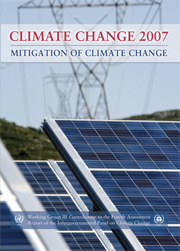 Climate Change 2007 - Mitigation of Climate Change
Climate Change 2007 - Mitigation of Climate Change EXECUTIVE SUMMARY
The concept of sustainable development was adopted by the World Commission on Environment and Development, and there is agreement that sustainable development involves a comprehensive and integrated approach to economic, social, and environmental processes. Discourses on sustainable development, however, have focused primarily on the environmental and economic dimensions. The importance of social, political, and cultural factors is only now getting more recognition. Integration is essential in order to articulate development trajectories that are sustainable, including addressing the climate change problem.
There is growing emphasis in the literature on the twoway relationship between climate change mitigation and sustainable development. The relationship may not always be mutually beneficial. In most instances, mitigation can have ancillary benefits or co-benefits that contribute to other sustainable development goals (climate first). Development that is sustainable in many other respects can create conditions in which mitigation can be effectively pursued (development first) (high agreement, much evidence).
Although still in early stages, there is growing use of indicators to manage and measure the sustainability of development at the macro and sectoral levels. This is driven in part by the increasing emphasis on accountability in the context of governance and strategy initiatives. At the sectoral level, progress towards sustainable development is beginning to be measured and reported by industry and governments using, for instance, green certification, monitoring tools, and emissions registries. Review of the indicators illustrates, however, that few macro-indicators include measures of progress with respect to climate change (high agreement, much evidence).
To save this book to your Kindle, first ensure no-reply@cambridge.org is added to your Approved Personal Document E-mail List under your Personal Document Settings on the Manage Your Content and Devices page of your Amazon account. Then enter the ‘name’ part of your Kindle email address below. Find out more about saving to your Kindle.
Note you can select to save to either the @free.kindle.com or @kindle.com variations. ‘@free.kindle.com’ emails are free but can only be saved to your device when it is connected to wi-fi. ‘@kindle.com’ emails can be delivered even when you are not connected to wi-fi, but note that service fees apply.
Find out more about the Kindle Personal Document Service.
To save content items to your account, please confirm that you agree to abide by our usage policies. If this is the first time you use this feature, you will be asked to authorise Cambridge Core to connect with your account. Find out more about saving content to Dropbox.
To save content items to your account, please confirm that you agree to abide by our usage policies. If this is the first time you use this feature, you will be asked to authorise Cambridge Core to connect with your account. Find out more about saving content to Google Drive.